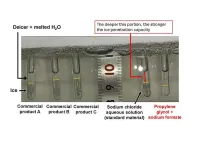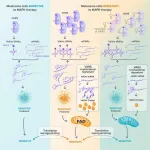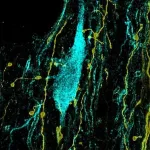(Press-News.org)
Fukuoka, Japan—In a paper published in Geophysical Research Letters, researchers have discovered that the turbulence in the thermosphere exhibits the same physical laws as the wind in the lower atmosphere. Furthermore, wind in the thermosphere predominantly rotates in a cyclonic direction, in that it rotates counterclockwise in the Northern Hemisphere and clockwise in the Southern Hemisphere.
The findings reveal a new unified principle for the Earth’s varied environmental systems and can potentially improve future forecasting of both earth and space weather.
One time or another we’ve tuned in to see the latest weather forecast, and while they give us a good idea of our daily atmospheric conditions the research that goes into studying how Earth’s air moves around is dizzyingly complex.
“At the fundamental level, we study the interplay of kinetic energy in the atmosphere at different sizes and scales, that energy is mostly in the form of wind and turbulence. Over the decades, a massive amount of data has given us insight into how this energy flows and dissipates to affect the weather in the troposphere, the lowest layer of the atmosphere” explains Professor Huixin Liu of Kyushu University’s Faculty of Science who led the study. “My research focuses on the movements in the upper atmosphere, specifically the thermosphere, where we explore the corresponding laws governing the dynamics and energy flow in the region.”
The thermosphere is a section of the atmosphere roughly 80-550 km above sea level and is often referred to as the gateway to space. It is a critical region for space operation, and is where you will find the International Space Station as well as most satellites. It is also where auroras are formed.
Liu collaborated with meteorology researcher Dr. Facundo L. Poblet of Leibniz Institute of Atmospheric Physics at the University of Rostock, whose work focuses on the dynamics and turbulence in the lower atmosphere below an altitude of 100 km.
“My research is in space physics, and I wanted to see if we could apply his meteorological methods to my research domain,” explains Liu.
The team analyzed the thermosphere wind data from two satellites, the Challenging Minisatellite Payload (CHAMP) and the Gravity Field and Steady State Ocean Circulation Explorer (GOCE). With the data, the team caculated the third-order structure function of the wind, a statistical quantity that provides information on the underlying turbulence. To their astonishment, they discovered that the thermosphere exhibits a similar scaling law from that of the lower atmosphere.
“This means that both the thermosphere and the troposphere—despite having drastically different atmospheric compositions and dynamics—follow the same physical laws. How turbulence moves, forms, and dissipates in these two regions are very similar,” continues Liu.
Despite remarkable strides in understanding the thermosphere, the intricate interplay of turbulence has remained largely elusive, and the team is happy that their findings shed new light onto this underexplored aspect of near-space dynamics.
“Similar to atmospheric weather forecasting, comprehending the energy distributions in the thermosphere is vital to advance our understanding of space dynamics,” concludes Liu. “We hope these findings can be used to improve space weather forecasting and ensuring the continued functionality and safety of satellite-based technologies essential to everyday life.”
###
For more information about this research, see "Third-order Structure Functions of Zonal Winds in the Thermosphere using CHAMP and GOCE Observations," Facundo L. Poblet, Huixin Liu, Jorge L. Chau Geophysical Research Letters, https://doi.org/10.1029/2024GL108367
About Kyushu University
Founded in 1911, Kyushu University is one of Japan's leading research-oriented institutes of higher education, consistently ranking as one of the top ten Japanese universities in the Times Higher Education World University Rankings and the QS World Rankings. The university is one of the seven national universities in Japan, located in Fukuoka, on the island of Kyushu—the most southwestern of Japan’s four main islands with a population and land size slightly larger than Belgium. Kyushu U’s multiple campuses—home to around 19,000 students and 8000 faculty and staff—are located around Fukuoka City, a coastal metropolis that is frequently ranked among the world's most livable cities and historically known as Japan's gateway to Asia. Through its VISION 2030, Kyushu U will “drive social change with integrative knowledge.” By fusing the spectrum of knowledge, from the humanities and arts to engineering and medical sciences, Kyushu U will strengthen its research in the key areas of decarbonization, medicine and health, and environment and food, to tackle society’s most pressing issues.
END
Neurons communicate electrically so to understand how they produce brain functions such as memory, neuroscientists must track how their voltage changes—sometimes subtly—on the timescale of milliseconds. In a new paper in Nature Communications, MIT researchers describe a novel image sensor with the capability to substantially increase that ability.
The invention led by Jie Zhang, a postdoctoral scholar in The Picower Institute for Learning and Memory lab of Sherman Fairchild Professor Matt ...
The dangers of frozen roads, airplane engines, and runways are well known, but the use of commercial products often means short-term safety over long-term environmental degradation. Seeking a better product, Osaka Metropolitan University researchers have developed a deicing mixture offering higher performance than deicers on the market while also having less impact on the environment.
The team, made up of graduate student Kai Ito, Assistant Professor Arisa Fukatsu, Associate Professor Kenji Okada, and Professor Masahide Takahashi of the Graduate School of Engineering, used machine learning to analyze ice melting mechanisms of aqueous solutions of 21 salts and 16 organic ...
Cells are signalled to have nutrients in excess, and this leads to malfunction and inflammation in organs such as the pancreas, the liver and the kidneys.
The finding, by CNIO researchers, are published in Nature Aging. It suggests that an intervention on the inflammation alone can relieve symptoms and increase survival.
The research has been conducted on animal models, but comparing their molecular processes with blood samples from people in their seventies indicates that they can be extrapolated to human aging.
The reality of a population who is ageing at an accelerated rate makes it a priority to understand what happens in the body over time, ...
An international research team led by scientists from the University of Liège has discovered an interesting new therapeutic target for the treatment of melanoma resistant to targeted therapies. Inhibition of the VARS enzyme could prevent this therapeutic resistance by resensitising tumours resistant to these targeted therapies.
Melanoma is one of the most serious and aggressive forms of skin cancer. When diagnosed early, melanoma is surgically removed. However, once metastases (i.e. secondary distant tumours) have developed, ...
‘I’m not gonna do this again’, we often say when faced with negative feedback, adverse effects, or disappointing outcomes. Thus, we attempt to learn from such negative experiences. This principle is also a cornerstone of our education system: failing an exam ought to encourage students to do better next time.
How does the brain achieve this type of learning? Positive and negative reinforcement appear as two sides of the same coin in parts of the brain’s valuation system. Notably, some neurons that release the neuromodulator ‘dopamine’ represent outcomes better vs. worse ...
In pausing to think before making an important decision, we may imagine the potential outcomes of different choices we could make. While this “mental simulation” is central to how we plan and make decisions in everyday life, how the brain works to accomplish this is not well understood.
An international team of scientists has now uncovered neural mechanisms used in planning. Its results, published in the journal Nature Neuroscience, suggest that an interplay between the brain’s prefrontal cortex and hippocampus allows us to imagine future outcomes in order to guide our decisions.
“The prefrontal cortex acts as a ‘simulator,’ ...
A team of Vanderbilt researchers has developed a wirelessly activated device that mimics the wavelike muscular function in the esophagus and small intestine responsible for transporting food and viscous fluids for digestion.
The soft-robotic prototype, which is driven by strong magnets controlled by a wearable external actuator, can aid patients suffering from blockages caused by tumors or those requiring stents. For example, traditional esophageal stents are metal tubes used in patients with esophageal cancer, mostly in an aging population. These patients risk food being blocked from entering the stomach, potentially ...
WASHINGTON, D.C.—The U.S. Department of Energy (DOE) today marked the two-year anniversary of the Biden-Harris Administration's launch of the U.S. Bold Decadal Vision for Commercial Fusion Energy with the release of the DOE Fusion Energy Strategy 2024 and an event at the White House co-hosted by the White House Office of Science and Technology Policy.
At the inaugural event where the Bold Decadal Vision was unveiled, DOE launched a Department-wide initiative to develop a strategy for accelerating the viability of commercial fusion energy in partnership with the private sector. The newly released DOE Fusion Energy ...
A study led by researchers from the University of Arizona Cancer Center at UArizona Health Sciences identified a biological mechanism that could lead to more effective treatments for breast cancer that has metastasized to the brain.
By studying the metabolic differences between primary breast cancer cells and those that metastasize to the brain, they determined that autophagy was significantly upregulated in brain metastases. Autophagy is a cellular recycling process that cancer cells can use to stay alive when faced with stressful conditions such as those triggered by anticancer drugs.
“The prognosis for individuals with ...
When we learn something new, our brain cells (neurons) communicate with each other through electrical and chemical signals. If the same group of neurons communicate together often, the connections between them get stronger. This process helps our brains learn and remember things and is known as long-term potentiation or LTP.
Another type of LTP occurs when the brain is deprived of oxygen temporarily – anoxia-induced long-term potentiationor aLTP. aLTP blocks the former process, thereby impairing learning and ...








